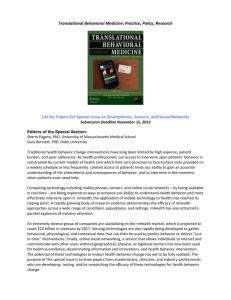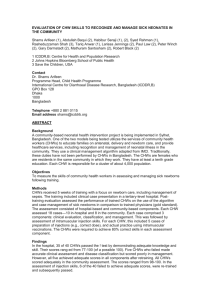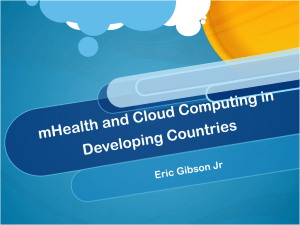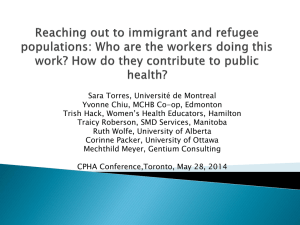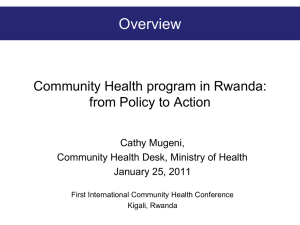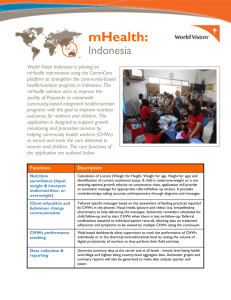Community Healthcare Worker Research Report
advertisement
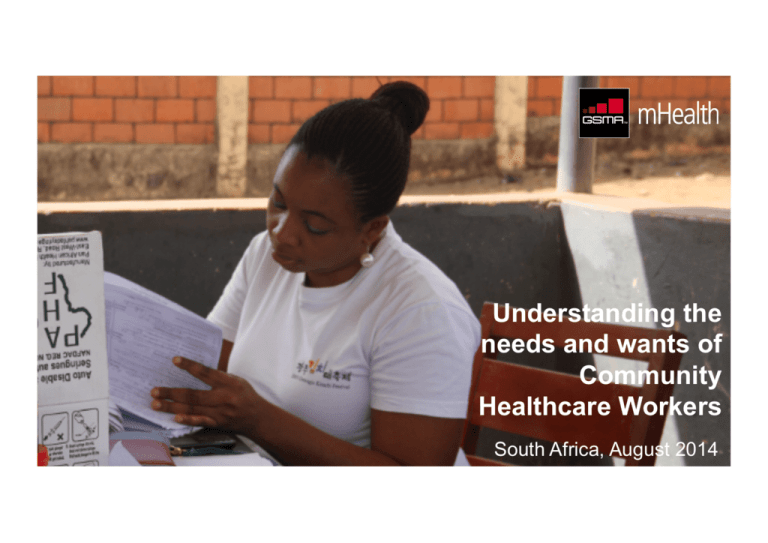
Do we have a more appropriate photo for this cover slide?
Understanding the
needs and wants of
Community
Healthcare Workers South Africa, August 2014 Table of contents
Overview and research objectives
3
About the GSMA
4
Summary, implications and recommendations
5
Research design overview and topics
6–7
CHWs: who are they?
8 – 11
CHWs’ hierarchy of needs
12 – 23
Appendix: glossary of terminologies
24
Correspondence
25
About the authors
26
Overview and research objectives
This work builds on the recently published End Consumer Primary Research and aims to inform health and mobile stakeholders about the users
of mHealth services in the public sector. The GSMA expects this market knowledge to lead to product design that is more aligned to the needs
of users (consumers and health workers), greater adoption and achievement of economies of scale and sustainability, and robust partnerships
between public and private sector stakeholders that ultimately reduce the widespread fragmentation of mHealth services in South Africa.
It is recognised that South Africa has a high per capita health expenditure with relatively poor health outcomes. One way in which the National
Health Insurance (NHI) aims to address this is through Primary Health Care (PHC) re-engineering, whose focus is to strengthen the district
health system (DHS), and to place greater emphasis on population health and outcomes. To achieve this, a strong emphasis will be placed on
decentralising health care delivery through ward-based PHC outreach teams. These teams will include community healthcare workers (CHWs),
responsible for delivering preventative, promotive, curative and rehabilitation services to families in their respective wards.
In the area of reproductive, maternal, newborn and child health (MNCH) specifically, CHWs provide support not only in the identification of
pregnant women but also in the collection of vital patient information. Their role is crucial in providing care and driving demand for early and
continual antenatal care (ANC), as well as for post natal care (PNC). Besides providing ANC and advocating for a healthy mom and baby,
CHWs provide social support and a critical communication channel between the health facility and the pregnant woman and her family.
Given the ubiquity of mobile phone technology in South Africa, we are seeing an increasing availability of mHealth tools that support and enable
CHWs to complete their work in a more connected, efficient and effective way. Companies and organisations like Cell-Life, Dimagi, Mezzanine
Ware and Mobenzi have created mHealth solutions that assist with household surveys, patient scheduling, data surveillance and tracking
systems for patient referrals to the closest healthcare facility for ANC or PNC.
The GSMA has conducted a number of focus group discussions, with more than 100 CHWs across five South African provinces, to understand
their personal and professional needs and wants, as well as to identify opportunities for improvements in mHealth tools which will assist and
strengthen the delivery of basic healthcare services in the communities that they serve.
About the GSMA
The GSMA represents the interests of mobile operators worldwide. Spanning more than 220 countries, the GSMA unites nearly 800 of the
world’s mobile operators with 250 companies in the broader mobile ecosystem, including handset and device makers, software companies,
equipment providers and Internet companies, as well as organisations in industry sectors such as financial services, healthcare, media,
transport and utilities. The GSMA also produces industry leading events such as Mobile World Congress and Mobile Asia Expo.
For more information, please visit the GSMA corporate website at www.gsma.com. Follow the GSMA on Twitter: @GSMA
GSMA Mobile for Development brings together our mobile operator members, the wider mobile industry and the development community to
drive commercial mobile services for underserved people in emerging markets. We identify opportunities for social, economic and
environmental impact and stimulate the development of scalable, life-enhancing mobile services.
For more information, please visit the GSMA Mobile for Development website at www.gsma.com/mobilefordevelopment. Follow GSMA Mobile
for Development on Twitter: @GSMAm4d
The GSMA Mobile for Development mHealth programme connects the mobile and health industries, with the aim of developing commercially
sustainable mHealth services that meet public health needs. In June 2012, the GSMA mHealth programme launched the Pan-African mHealth
Initiative (PAMI) to support the scale-up of mHealth in nutrition and maternal and child health. PAMI is closely aligned to the UN’s Every Woman
Every Child Initiative, Scaling Up Nutrition (SUN) and the Global Nutrition for Growth Compact.
For more information, please visit http://www.gsma.com/mobilefordevelopment/programmes/mhealth
Summary, implications & recommendations Considerations for service design
Key findings
•
CHWs play a crucial frontline role and have a positive impact on the
communities they serve
•
As information gate-keepers, they could provide support beyond
healthcare
•
Addressing their eight identified basic needs will provide
empowerment
•
Technology is highly valued; however, existing mHealth tools are not
fully utilised and are used primarily as communication and data
collection tools
•
While a smartphone is the best phone type that can deliver “ideal
phone features”, it is also feasible to support CHWs by offering
services that can be accessed through SMS, USSD, IVR or voice
channels
•
Is it feasible to tap CHWs for the delivery of other social support services?
•
How can mHealth tools be modified to fit with these new potential roles?
•
How can technology be used to meet more of their basic needs?
•
Can the provision of training and technical support allow them to maximise
the usage of existing tools?
•
What tool features should be developed and prioritised in order to strengthen
patient care and the delivery of other basic healthcare services, improve the
knowledge of CHWs and develop commercially sustainable business models
for mHealth?
Recommendations:
•
The broadening of mHealth tool features and capabilities, along with regular training, will help support CHWs in their day-to-day work beyond health
•
CHWs could potentially be tapped as mobile agents, allowing them to supplement their current low, and in some cases non-existent, stipend, although this
could distract from the fulfilment of their primary healthcare responsibilities
•
The identification of CHWs who can be become informal “tech champions” in order to explain and optimise the usage of existing tools with fellow CHWs
•
Develop a data- and cost-efficient “WhatsApp” type app that allows moderated inter-channel communication (i.e. between the app and SMS) and that can
be used by CHWs to communicate with patients and fellow CHWs
Research design overview 100+ CHWs were interviewed across 5 provinces: Western Cape, Gauteng, Eastern
Cape, KwaZulu Natal and North West
1
2
Non-user
user
20 – 35 y.o.
Organisations
• Donor: UK aid from the
Department for International
Development (through Mott
MacDonald)
• Project oversight: GSMA
• Respondent recruitment and FGD
moderation: Ask Afrika
Respondents
• 13 groups of CHWs who have
some MNCH-related responsibility
• 7 are users or have used mHealth
tools and 5 are non-users
• 6 groups are aged 20 – 35 year old
and 7 groups are aged 36 – 50
years old
Methodology
• 1.5 hour focus group discussions
20 – 35 y.o.
Johannesburg
(Urban)
Rustenberg
2
user
One 20 – 35 y.o.
One 36 – 50 y.o.
1
user
36 – 50 y.o.
1
user
(Semi-Urban/Rural)
u
v v
Ekurheleni
(Urban)
2
Non-users
20 – 35 y.o.
36 – 50 y.o.
1
u
Non-user
36 – 50 y.o.
Cape Town
(Urban)
Durban
(Urban)
1
Non-user
36 – 50 y.o.
Port Elizabeth
v(Semi-Urban/Rural)
y
1
user
36 – 50 y.o.
1
Non-user
36 – 50 y.o.
Fieldwork dates
• 12 groups: 27th Mar – 4th Apr, 2014
• 1 group: 5th May, 2014
Research topics Personal life
•
Who or what is a CHW?
•
What is her/his personal background?
•
What are her/his aspirations in life?
•
What motivated her/him to become a CHW?
Professional life
•
What are her/his job responsibilities?
•
What challenges are faced at work?
•
How can those challenges be addressed
and how can she/he be assisted to meet
the healthcare needs of the community
served?
Community Healthcare Workers Technology: mHealth tools
•
What is the role of technology in her/his
personal and professional life?
•
How can mHealth tools assist at work?
•
Among users: what is her/his experience
with existing mHealth tools?
•
Among non-users: how does she/he
perceive mHealth tools? what are the
potential adoption barriers?
CHWs: who are they?
CHWs play a crucial role in the South African public healthcare system as front-liners who provide health information as well as basic healthcare
services. They act as community caretakers, counsellors and protectors as well as information gatekeepers, informing their patients of their
right to apply for social grants, for example.
Because of their contribution to society, CHWs have a strong sense of fulfilment in life. But just like the patients they serve, they are mired in
poverty. While most are paid an average of R1,500 per month, similar to the minimum wage required by law, a few do not receive any stipend
at all. The majority say they are motivated to stay at work because they genuinely like to help people. The reality is that many CHWs are
trapped because they feel they have very limited opportunities, due to age (for those who are older) and lack of adequate qualifications.
All of the CHWs who participated in this study are highly capable individuals. Many of the younger CHWs dream to become either nurses or
social workers and see their CHW role as a stepping stone to further achievements. They crave knowledge, to improve their chances of better
job opportunities and to better serve their patients..
Some CHWs in South Africa are quite fortunate because they are now formally being integrated into the Ward Based Primary Health Care
Outreach Teams (WBOT). The majority continue to work through NGO’s, civil society organisations or simply as “volunteers” with little to no
formalisation of the market to foster economic and personal growth.
As discussed in the succeeding section of this report, there are a number of ways to empower CHWs who are less fortunate. Some of these
needs can be addressed with relatively low effort and investment. The provision of mHealth tools can address a greater collection of needs,
requiring a higher investment, but potentially also delivering a higher return, in terms of impact and the improved health of the populace. We
discovered that many CHWs are already using smartphones and, as they experience the value of mHealth tools, many would be willing to pay
some amount to gain access to Mobile Value Added Service (mVAS) that would allow them to better fulfil their duties. In fact, many are already
using their own personal phones to communicate with and provide assistance to fellow CHWs, and to reach out to patients.
Being a CHW provides a sense of fulfilment
But most of them are still mired in poverty just like the patients they serve
“I am doing this because back in 1999, I didn’t
know anything about HIV. I lost my younger
Purpose: helping others
“I really want to become a nurse. Since I don’t have
her two kids. When I see kids like them, I feel
the need to love and help them. So I help by
money to support myself go to school, I ended up
educating them to help stop the pandemic.”
becoming a CHW. There’s not enough money here. But
it taught me a lot about patient care. So maybe this will
sister to HIV and I eventually had to take care of
Status: achieving career aspirations
(20 – 35 y.o., mHealth tool non-user, Ekurhuleni)
help me become a nurse one day.”
(20 – 35 y.o., mHealth tool non-user, Rustenberg)
“My job allowed me to deal better
Empowerment: educating self and others
is a problem even if she doesn’t tell
and I thought that by being a CHW, I
me. I can say that my work has
can earn some pocket money while
(20 – 35 y.o., mHealth tool user, Johannesburg)
experience with my clients who are
rape victims. Now, I know that there
“I was having difficulty finding a job
being able to help other people.”
with my daughter because of my
Economic: additional source of income
helped me become a better mother.”
(35 – 50 y.o., mHealth tool user, Cape Town)
CHWs are highly capable and strongly motivated
Younger CHWs see the role as a stepping stone to becoming a nurse or social
worker. Older CHWs feel trapped, due to age and lack of other options
“… [After just ] a few months, I am already acting as a
community health counsellor. But I’m not here to stay in
this field forever because I want to see myself as a nurse
one day… and that’s my dream.”
“[While I would like to be a nurse,] I do not want to lie, I do not see myself like that
because I’m 44 years old already and I do not know where I am going to be in five years
because by then I will be almost 50. So I do not know, it is only God that knows if I will
become a nurse one day.”
(36–50 y.o., mHealth tool non-user, Port Elizabeth)
(20 - 35 y.o., mHealth tool non-user, Rustenberg)
20 -35 year olds
Education:
Younger CHWs tend to be better educated
than older CHWs
•
The majority (3 in 5) have completed post-matric
education, have technikon diploma/degree or have adult
basic education and training
Marital status:
Younger CHWs tend to be single mothers
•
The majority (3 in 5) are single or have never been
married, and have an average of 1 to 2 children
•
Consumer behaviour:
Most CHWs are generally tech savvy
•
•
36 – 50 year olds
•
The majority (3 in 5) have some secondary or have
completed secondary education with the remaining 2 in 5
having post matric, diploma or technikon diploma/degree
•
The majority (4 in 5) are married or cohabit with their
partner, with an average of 2 children
Some have grandchildren already
•
The majority, regardless of age, are already using smartphones although those who are rural-based continue to use basic
phones
The majority (3 in 5) continue to have strong affinity with Nokia because it is perceived to be more durable. The remainder
use primarily Samsung or BlackBerry
Among smartphone users, the majority use WhatsApp for work and personal reasons – they create WhatsApp groups to
communicate with fellow CHWs and patients
CHWs contribute beyond health Broadening the scope of existing mHealth tools to include delivery of other social
services (e.g. social grant application) could widen opportunities for all stakeholders
• Generalists focus on broader disease areas and are called Community Healthcare Worker (CHWs) or Community Care Givers (CCGs).
They tend to be non-users of mHealth tools
• Specialists tend to be more qualified and are called counsellors, mentor mothers or educators. Most are already using mHealth tools
Healthcare front-liners
Household visits:
• Gather household/patient information
• Health education and dissemination of information about
government healthcare programmes
• Check patient status, whether treatment is up-to-date;
whether babies are fed and whether patients take
medication on time
• Explain to patients the importance of having ANC/PNC,
HIV tests or immunisations, convince them to go to
healthcare facilities for such services and accompany
them, if necessary
• Remind patients of clinic appointments and follow up on
those who default
• Collect medication from clinics for old/immobile patients
• Refer emergency cases to clinics/hospitals
Healthcare facilities
• Record-keeping
• Provide basic assistance to nurses
Counsellors/
protectors
Care takers
•
•
•
•
Feed and take care (e.g.
giving a bath) of the young,
invalids and elderly
Do household chores for
weak or sickly patients
Teach patients how to plant,
to have something to eat
Assist orphans with their
homework
•
•
•
•
•
Community assessment:
•
check the general needs of the
community
Report physical and emotional •
abuse in the community to the
police authority
•
Provide counselling among
rape or trauma victims
Advise on ensuing legal
proceedings
Listen to women’s personal
issues
Information
gatekeepers
Inform patients/clients of their
rights and refer them to social
services
Assist with social grant
applications
Assist on how to obtain an
identification document or a
birth certificate
The hierarchy of needs of the CHW
In order to fully empower CHWs, it is important to address their basic needs. 8 needs have been identified, commencing with (1) stipend
received and access to (2) protective clothing, especially as many deal with infectious diseases. To better address the healthcare needs of
their patients, CHWs desire to improve their (3) knowledge of first aid administration in cases of emergency.
As some CHWs work in communities where they are not originally from, (4) security is another fundamental need and indeed a worry for
CHWs. Gaining their (5) supervisors’ respect is also critical, as many feel that their supervisors do not value their contribution at the front line
of the healthcare system.
In spite of the difficulties encountered with some patients, including lack of active appreciation, CHWs possess a strong sense of fulfilment from
(6) client respect, especially when they see a patient’s condition improve or a patient become healthier.
When asked whether (7) technology is important in their professional life, CHWs, especially those who are already using mHealth products/
services, strongly expressed that these products/services have had a strong positive impact on their day-to-day work, by helping them to focus
more on patient care and less on administrative tasks. They also believe that there exist opportunities to improve current products/services, to
improve both personal and patient experience. One group expressed disappointment when their mHealth products/services were taken away
after a three-month trial. For those who do not yet have access to mHealth products/services, the use of personal mobile phones allows CHWs
to communicate with their patients to answer questions regarding conditions, remind them of their treatment appointment or the need to take
medication on time.
This section of the report illustrates that the use of mHealth products/services can help address most of the identified basic needs including
using it potentially as a (8) badge or a form of identification as an alternative to a uniform. But there are some reported reservations among a
few CHWs who prefer not to be identified as a CHW for fear that a special case patient will in turn be identified by neighbours and stigmatised.
(Note: numbers refer to ranking in terms of importance as illustrated on the succeeding slide)
Technology is perceived to be a valuable tool CHW hierarchy of needs
More essential
Less essential
Addressing the fundamental needs of CHWs is crucial if they are to be empowered.
Technology, especially mHealth tools, can help address some of their basic needs
Uniform
|
Technology
{
z Respect from clients
yRespect from supervisors
Security
x
w Knowledge/training
v Protective clothing
Stipend
u
“I can’t do my job without these tools. [When you get used to it], everything becomes
quicker. There is no need for paper and pen, which puts some patients off because they don’t
like to write or sign the consent form on paper.”
(36 – 50 y.o., mHealth tool user, Western Cape)
“Our supervisors undermine us. With this tool, I can help prove to them that I do my job well
and not just the messenger that they think us to be.”
(20- 35 y.o., mHealth tool non-user, North West)
“With our phones, we get the support from fellow CHWs that sisters [or nurses] are unable to
provide to us.
(36 – 50 y.o., mHealth tool non-user, Eastern Cape)
“We want a tool that will allows us to have access to information [about health and our work].
Because now, we don’t really know very much so a tool that will help improve our knowledge
would be very much appreciated.”
(20 – 35 y.o., mHealth tool non-user, Gauteng)
CHWs receive on average R1,500 per month CHWs could potentially become mobile agents, allowing them to supplement
their stipend
With many CHWs being single-parents, it is not
surprising that they struggle to survive with whatever
money is left for household expenditure after
deducting work-related expenditure from their
monthly stipend
Estimated share of expenditure from CHW monthly stipend
0% - 5%
|
Uniform
{
Technology
z
Respect from
clients
y
Respect from
supervisors
x
w
Security
Knowledge/
training
v
Protective
clothing
u
Stipend
55% - 95%
Helping others: out of compassion, some CHWs spend
their own money to buy food for patients who couldn’t take
medication because they have nothing to eat
“Being able to help other people, I feel fulfilled working as a CHW.
But I could hardly survive with the amount of money I receive
every month. When I need emergency money, no bank would lend
me because they think I have no income to pay for it and also
because I have no collateral for the loan.”
Household expenditures: food, housing, utilities,
children’s school/crèche fees, etc.
(36 – 50 y.o., mHealth tool non-user,
Rustenberg)
NGO
0% - 5%
5% - 15%
0% - 20%
Personal needs: toiletries and, occasionally, fashion or
cosmetics
Mobile top-ups: CHWs sometimes use their own phone to
reach out to patients, fellow CHWs or nurses/doctors
Transportation: not all CHWs live and work in the same
community, so some spend a considerable proportion of
their stipend on transportation. They also spend their own
money to take patients to a healthcare facility or when they
collect patients’ medication.
•
•
mHealth users tend to be paid and have fixed-term contracts
Some non-users get paid but others get paid only occasionally; a few
do not get paid at all – they work on the premise that they will be
hired eventually, without knowing when/if this will really happen
Government
•
Government-contracted CHWs get paid but most have fixed-term
contracts just like their NGO-counterparts
CHWs often deal with infectious diseases mHealth tools could potentially include a safety check list, to drive awareness of
and demand for personal protective equipment among CHWs
While CHWs who deal with infectious patients need personal protective equipment (e.g. masks and
gloves), there also exists a fear that these create barriers between them and their patients
|
Uniform
{
Technology
z
Respect from
clients
“No we don’t get any of these [masks or gloves]. I
hope that you understand that because we are
y
Respect from
supervisors
x
w
Security
Knowledge/
training
v
Protective
clothing
u
Stipend
only care givers, we ourselves do not have
medical cover. So if you contract the disease, you
go to the clinic just like everyone else.”
(20 - 35 y.o., mHealth tool nonuser, Rustenberg)
“There are times when nurses send us to the TB room and there
will be TB patients some of whom have MDR. But we care givers
are not protected. We are really at risk. In fact, one of us is now
infected with TB as we speak. She has not yet recovered and
being sick makes it her own personal problem. She has to make
her own plans on how she gets cured. It seems it’s no one
else’s business. The senior nurses are having something to
“We know some community caregivers who have
drink to prevent catching infection. But we caregivers, we don’t
died as they were exposed to [infectious
get anything.”
diseases].”
(36 - 50 y.o., mHealth tool non-user,
Durban)
(20 - 35 y.o., mHealth tool nonuser, Rustenberg)
CHWs crave knowledge mHealth tools can be used as a repository of training materials, accredited
continual professional development and incentivised learning
In order to do better at work and gain promotion, the majority are keen to learn. Training / workshops are only
carried out once or twice a year and tend to focus on what they already know. Providing training certificates,
which can be used as a proof of eligibility to promotion, can inspire CHWs to improve their knowledge and
skills, thereby strengthening healthcare delivery
|
Uniform
{
Technology
z
Respect from
clients
y
Respect from
supervisors
x
w
Security
Knowledge/
training
v
Protective
clothing
u
Stipend
Basic training needs
•
Technical
skills: Healthrelated matters
•
•
•
Soft skills:
Dealing with
emotional issues
•
Disease-related information (e.g. Reproductive
health/MNCH, HIV/AIDS, TB, nutrition, etc.) and
understanding disease symptoms
How to conduct first-aid, basic diagnostics and how
to deal with emergency cases
How to deal with infectious diseases so they will
avoid contracting them
Listening and counselling skills: learning how to
become more confident and persuasive in dealing
with difficult patients or special cases (e.g. rape
victims) to make them “open up” or make them
become more cooperative
Stress management
Advanced training needs
•
Getting blood samples for testing
•
Taking blood pressure measurement
•
Using pregnancy test kits at patient’s residence
•
Measuring blood sugar level
“[After listening to painful stories of rape
victims], you feel the stress, too. You yourself
need some counselling because of all those
emotional stuff. So it’s so difficult when we get
home, we carry the emotional burden. So when
we speak with our own children, we speak
louder and shout at them.”
(36 – 50 y.o., mHealth tool user, Cape Town)
Not all CHWs live & work in the same community mHealth tools can be used as security, rather than a liability, by equipping them with
anti-theft features such as a panic button and a GPS tracker
CHWs who live and work in two different communities can feel unsafe (and in need to look over their
shoulders) at work. While most would like bigger touch screens, they are wary that these may make them
targets for robbery
|
Uniform
{
Technology
z
Respect from
clients
y
Respect from
supervisors
x
w
Security
Knowledge/
training
v
Protective
clothing
u
Stipend
“Another big challenge, in areas
where we work, we are not safe. So
I must take off my ring, earrings and
necklace. I work in an area that is
very naughty because when we go
there, people frighten us saying
that we must be careful. So every
time we go there for work, we pray
hard in God’s name because we do
not know what may happen to us.
And we pray that we can go back
home safely.”
(36 – 50 y.o., mHealth tool non-user,
Port Elizabeth)
“Because these phones we are using for work
belong to the organisation, they say that if we lose
them, we will have to pay for them. Having GPS
tracker is important so when I am robbed, I could
ask them to check the device’s location and
confirm that I didn’t steal it myself and that it is in
someone else’s possession.”
(36 – 50 y.o., mHealth tool user,
Cape Town)
“I was robbed once of all my possessions except
for my phone. It would have been a disaster
because I have got my work scripts saved there.
My phone is my life so I was lucky that I managed
to keep it.”
(20 – 35 y.o., mHealth tool user,
Johannesburg)
“There are lots of crime in our
neighbourhood and lots of people
doing drugs so I feel unsafe.”
(20 – 35 y.o., mHealth tool user,
Johannesburg)
If your cell phone is robbed, my
organisation can’t pay for it. But
when I do home visits, they would
still want to contact me. How do
you think I can answer them if I
don’t have a phone? So I fear
getting my phone stolen.
(36 – 50 y.o., mHealth tool non-user,
Cape Town)
Supervisors can help motivate CHWs mHealth tools improve communication between CHWs and their supervisors. They
can help provide clarity on job objectives and allow progress tracking
While some CHWs feel that their supervisors value their contributions, others feel they are being treated as
clerks / data collectors / messengers
Setting targets or objectives
|
Uniform
{
Technology
z
Respect from
clients
y
Respect from
supervisors
x
w
Security
Knowledge/
training
v
Protective
clothing
u
Stipend
•
•
•
Not all have clear objectives; those who have set targets tend to
have a better relationship with supervisors and be more
motivated at work
A typical target would be to visit an average of 0 patients or
households per day
Sometimes, “illogical” or unreasonable targets can cause
confusion and frustration
“During our monthly meeting, they will be
reporting that rape case numbers have
dropped. They don’t like that. They want us
to report 100 rape cases per month. But it’s
not possible because you cover the same
households. What do they want us to do? I
say to them ‘Give us penises for us to go
and rape so we can reach our rape
targets.’”
(36-50 y.o., mHealth tool user, Cape Town)
Feedback and empathy
•
•
Feedback on performance and coaching gives CHWs a
sense of belonging and achievement
A supervisor’s empathy and sense of urgency towards
patients with emergency cases can make CHWs feel their
work is being valued which in turn helps strengthen their
relationships with patients
“We don’t get
support from our
seniors. Instead, they
discourage you and
will sometimes make
you feel like you
don’t exist at all or
you are nothing.”
(20 - 35 y.o., mHealth tool
non-user, Rustenberg)
“They don’t care much. If one of our patients is
sick and you take them to one of the nurses, they
will say ‘Yo, I’m so busy’. You’re left with no
choice but to send your patient back home. The
following day the same patient will be seriously
sick. This situation is very painful because you
treat a patient with love. The patient trusted you
so much, but then when we get at the clinic that
kind of situation makes it somehow worse.”
(20 - 35 y.o., non-user, Rustenberg)
Experience with CHWs is generally positive Technology can potentially allow CHWs to focus on more essential tasks, increasing
visit frequency and households visited, and therefore improving patient experience
Patient empathy and respect and CHW expertise are the strongest drivers of a positive patient experience. In
general CHWs are valued by patients but on occasions they are disrespected, because of the view that they
are not real nurses
|
Uniform
{
Technology
z
Respect from
clients
y
Respect from
supervisors
x
w
Security
v
u
Knowledge/
training
Overall experience with CHWs
Base: among those who have been visited by a CHW
Excellent
18%
57%
Very Good
39%
Good
Fair
34%
8%
Protective
clothing
Poor 1%
“I help lots of sick people.
Some are more sick than
others but all of them need
help. After a month of helping
them, you see a change in
them, that they become a lot
better than before. Despite all
the challenges in this work,
this encourages me… that, at
least, I have done
something… that I made a
difference in somebody’s
life.”
(20 – 35 y.o., mHealth tool nonuser, Rustenberg)
Stipend
Source: Consumer research
CHW visit
58%
Base: among all respondents
24%
Haven’t seen one / Don’t know
Knew one but she never visited
19%
Ever visited by a CHW
Frequency of visit
(Ave. per month = 2)
Base: Among those who have been visited by a CHW
Once a week
Twice a month
Once a month
Once every 2 months
Visited once or twice over the
past 6 months
Source: Consumer research
22%
19%
16%
25%
22%
Existing tools already impact on the work of CHWs Primarily used as communication and data collection tools, existing mHealth tool
features are not fully utilised
About 1 in 7 households had their information noted by phones
Unutilised
Utilised
|
Uniform
{
Technology
z
Respect from
clients
y
Respect from
supervisors
x
w
Security
Knowledge/
training
v
Protective
clothing
u
Stipend
Communication
tool
• Communicate with
colleagues and
patients
• Call the healthcare
facility to deal with
emergency cases
Data
collection
tool
• Gather
demographic
profiles and
healthcare
conditions of
patients
Resource / patient
care
Planning and
security
• Appointment reminder/ •
plan which households
to visit
•
• Identify the exact
address/location of
patients
• Referral/booking
system for appointment
• Track progress of CHW
targets
• Track patient progress
Continual
professional
development
Access to training
materials
Enable objective
assessment
Diagnostics
• Checklist to assess
the condition of
patients and refer
them to emergency
services, if
necessary
Technology is highly valued despite difficulties
Informal tech-champion CHWs could be identified, to explain and optimise the use of
existing mHealth tools with fellow CHWs
Incremental improvements in CHW experience can be achieved through training. Radical improvements require
stronger stakeholder support
|
Uniform
{
Technology
z
Respect from
clients
y
Respect from
supervisors
x
w
Security
Knowledge/
training
v
Protective
clothing
u
Stipend
Community
• 1 in 4 patients feel
uncomfortable when giving out
information
• Unsafe to walk around with
gadget – “If I lose it, I pay for it”
Tech provider
• Not enough training/
knowledge
• Don’t know who to ask for
technical support
CHWs
Employer/supervisor
• Inertia – fear of change
• “It is good but paper & pen is
faster and allows me to spend
more time with my client”
• No clarity as to what the data is used
for or why data gathering is important
• Supervisor sometimes is a deterrent
• Doctors/coordinators do not have
access to database, requiring CHWs
to also maintain paper & pen records
Barriers to fully
utilising mHealth tools
Hardware
• Low-end smartphone: “memory
is too small and speed is so
slow and constantly hangs”
Mobile operator
• Network connectivity issues
• Price perception – “consumes R50 in
2 to 7 days”
Software
• Not so easy to use
• “Some data points can’t be
captured correctly” (e.g. age of
babies who under 1)
“Technology is not
safe. If the phone is
lost, somebody might
be able to get hold of
patient information.
Because when patient
data is mapped with
the software and
when it is hacked,
then the patient can
be easily identified
and his information
compromised.”
(20 – 35 y.o. CHW coordinator,
mHealth tool user, Johannesburg)
The smartphone can deliver ideal tool features Some features can also be offered via SMS, USSD, IVR or voice, allowing basic
phone owners to improve delivery of healthcare to communities
|
Uniform
{
Technology
z
Respect from
clients
y
Respect from
supervisors
x
w
Security
v
u
Knowledge/
training
Protective
clothing
Stipend
Ideal features: prioritisation hierarchy
Purpose
Patient care
planning
CHW needs
•
•
•
Data
collection
•
Resource
planning
and security
•
Continual
professional
development
•
•
•
•
Communication
•
•
Communication
and
diagnostics
•
Basic phone solutions
Alert system for patients who missed
appointments
Medication reminder
•
SMS or IVR
Using “paper & pen” is sometimes preferred –
more time to focus on patients; minimise duplicate
work
Data back-up
•
(None)
•
Security: short code as a
panic button
•
USSD or IVR
Identify the patient’s location quickly / know area
boundary / appointment system;
Security: fear of getting robbed and losing phone
Improve knowledge about patients / diseases as
well as counselling techniques
Test new knowledge learned
Communicate with patients: follow ups, healthrelated questions
Communicate with fellow CHWs/ nurses/ doctors:
ask for support
Communicate with police: emergency cases (e.g.
report abuse, CHW victim of robbery)
Ability to diagnose/conduct basic triage and refer
emergency cases to healthcare facilities
•
SMS and/or Voice
•
Voice: emergency
services hotline
•
USSD-based algorithm
Feature / smartphone solutions
•
Web- / app-based system linked to mapping system
•
Web- / app-based system that sends SMS auto-reminder to
patients to take medication
•
Camera with character-recognition app
•
Voice recording capabilities
•
Google or similar mapping service that provides the best
recommendation on routing / closest healthcare facility and
has GPS tracking device
•
Google search / access to web portal with health-related
education materials / TedEx style videos
•
Web- / app-based testing system (with gaming component)
•
WhatsApp group, social media (e.g. Facebook, Twitter,
Patients Like Me type, LinkedIn type for CHWs)
•
Camera/video-enabled phone to send photo/video to doctors
for confirmation of emergency cases
•
Built-in triage app and access to home made remedies
•
Remote diagnostic solutions
•
Camera/video-enabled phone to send photo/video to doctors
for confirmation
A uniform can help some CHWs gain respect While mHealth tools can potentially be used as work badges, some CHWs fear
that they are unsafe to use as they may become targets for robbery
Some CHWs already have uniforms. Among those who don’t, the generalists want a uniform, to be seen more
professionally by patients, while specialists do not see the need due to some patients’ fear of getting
stigmatised by neighbours for being sick
|
Uniform
{
Technology
z
Respect from
clients
y
Respect from
supervisors
x
w
Security
Knowledge/
training
v
Protective
clothing
u
Stipend
“I do lots of things like getting blood pressure,
conducting blood test… but I dress like a civilian,
and that causes the patient to mistreat me [because
I am not dressed up like a nurse.]”
(20 - 35 y.o., mHealth tool non-user,
Rustenberg)
“Having one saves us
[money]. Sometimes,
we work at the hospital
where we are
supposed to be formal.
But we don’t have a
uniform.
(36-50 y.o., mHealth tool non-user,
Cape Town)
“Having uniform is
good. When we visit a
person, they can
recognise us and it’s
easier to get people’s
trust. And it makes us
presentable and tidy”
(36-50 y.o., mHealth tool
user, Cape Town)
“Wearing a uniform in a
facility is good. To go on
home visits and you are
wearing a uniform [which
says TB, for example],
people run away and
therefore you can’t do home
visits anymore.”
“Sometimes, I don't
like uniform as people
tease us that we are
not really a nurse and
just act like one.”
(36-50 y.o., mHealth tool nonuser, Cape Town)
(36-50 y.o. , mHealth tool user,
Cape Town)
“I can’t say that I really want to wear a uniform. If our
clients see a uniform, they think of us as a nurse or
investigating officer, who they normally turn away.”
(36-50 y.o., mHealth tool user, Cape Town)
Appendix: glossary of terminologies ANC
Antenatal Care
CHW
Community Healthcare Workers, also known as Community Care Givers (CCGs), lay health advisors, village health workers, community health
aides or community health promoters. They are the healthcare systems’ front-liners and they provide health or medical information as well as
basic care to the communities in which they reside
IVR
MDR
Interactive Voice Response
Multidrug-Resistant Tuberculosis
mHealth
Mobile Health or health services delivered using mobile phones or supported by mobile devices
mHealth
Tools
Mobile-based job-aid tools that are provided to CHWs. These are essentially mobile phones that run various applications or programmes
provided by organisations like Cell-Life, Dimagi, Mezzanine Ware or Mobenzi that perform various functions including data gathering of patient
information (instead of using “paper & pen”) or resource/patient care planning
MNCH
Maternal, Newborn, and Child Health
mVAS
Mobile Valued-Added Services are services offered by mobile operators to consumer segment beyond standard voice, SMS, MMS and data
services
PNC
Postnatal Care
SMS
Short Message Service
USSD
WBOT
WhatsApp
Unstructured Supplementary Service Data
Ward-Based Outreach Teams are part of the primary healthcare re-engineering programme in South Africa, in which CHWs are integrated in the
delivery of healthcare services to communities, families and individuals at community-based institutions and at a household level
WhatsApp is a instant messaging smartphone application that uses data communication. Besides text messaging, it allows users to send images,
audio and video media messages to other users
Correspondence
For information directly related to this research report, please contact:
Mojca Cargo
mcargo@gsma.com
For general inquiries on the GSMA mHealth programme, please contact:
mhealth@gsma.com
For general inquiries about the work of the GSMA, please visit:
www.gsma.com
About the authors
Mojca Cargo
As Mobile for Development mHealth Project Manager, Mojca oversees the
implementation of the Pan-African mHealth Initiative (PAMI) in South Africa.
She joined the GSMA in 2011 as Programme Coordinator and Research
Analyst responsible for managing the mHealth Tracker and sharing mHealth
knowledge through various social media channels. Mojca has an Economics
degree from the University of Ljubljana, Slovenia and an MBA from the
Grenoble Graduate School of Business, France.
Fernan “Perry” Flores
As Mobile for Development mHealth Insights Manager, Perry is responsible for
managing consumer research. He has also provided support across a number
of Mobile for Development verticals including mWomen, mLearning, mDiabetes
and mAgri. Perry has a BS in Management Engineering from the Ateneo de
Manila University, Philippines and an MBA from the Judge Business School,
University of Cambridge, UK.
This document is an output from a project funded by UK aid from the
Department for International Development (DFID), managed through Mott
MacDonald, for the benefit of developing countries.
The views expressed are not necessarily those of DFID or Mott MacDonald.
